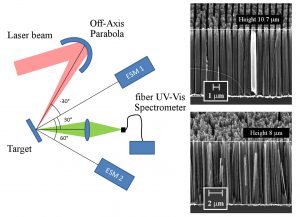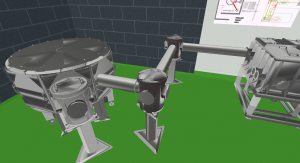Laser-matter interaction with ultrashort-pulses at high intensity strongly depends upon energy absorption by the surface of the material. Energy is mostly converted in kinetic energy of electrons while much he avier ions remain still during the laser pulse. What happens when we use a NANO-SCALE COMB-LIKE SURFACE instead of a flat surface? What is the role of the comb wires? We know that in this ultra-intense, ultra-short pulse regime, electrons are ripped off from the surface and start oscillating abruptly. In general, however, experimental results on energy absorption are contradictory and strongly affected by experimental conditions. A recent study promoted by CNR in collaboration with TIFR (Mumbai), with the participation of INFN and INAF, sheds light on this complex process, comparing combs with different wire spacing. Experimental results show that if the extent of the oscillation is large compared to the wire spacing, electrons hit the wires frequently losing energy, and their motion becomes stochastic. In contrast, if the excursion of the oscillation is small compared to the wire spacing, the motion of electrons is coherent with the laser light and more electrons acquire more energy. These experimental results, well described by the numerical model developed for this study, opens new possibilities for the control of laser absorption, with potential applications to light ion acceleration with lasers, where control of energy absorption plays a crucial role.
avier ions remain still during the laser pulse. What happens when we use a NANO-SCALE COMB-LIKE SURFACE instead of a flat surface? What is the role of the comb wires? We know that in this ultra-intense, ultra-short pulse regime, electrons are ripped off from the surface and start oscillating abruptly. In general, however, experimental results on energy absorption are contradictory and strongly affected by experimental conditions. A recent study promoted by CNR in collaboration with TIFR (Mumbai), with the participation of INFN and INAF, sheds light on this complex process, comparing combs with different wire spacing. Experimental results show that if the extent of the oscillation is large compared to the wire spacing, electrons hit the wires frequently losing energy, and their motion becomes stochastic. In contrast, if the excursion of the oscillation is small compared to the wire spacing, the motion of electrons is coherent with the laser light and more electrons acquire more energy. These experimental results, well described by the numerical model developed for this study, opens new possibilities for the control of laser absorption, with potential applications to light ion acceleration with lasers, where control of energy absorption plays a crucial role.
Intense Laser Irradiation Laboratory
National Institute of Optics – National Council of Research

 First laser shots on solid targets have been carried out in the new interaction chamber…
First laser shots on solid targets have been carried out in the new interaction chamber…